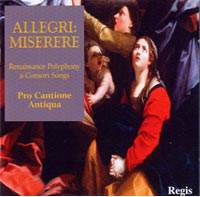The music on this disc comes from two sources: firstly
performances of unaccompanied choral music by the group Pro Cantione
Antiqua; and secondly solo works sung by countertenors Paul Esswood
and James Bowman and tenor James Griffett all accompanied by the English
Consort of Viols. Unfortunately, there is no information in the notes
or on the cover (that I could find) to tell me where and when the recordings
were made, which is frustrating. I managed to track down the Allegri
Miserere to an I.M.P. disc issued in 1985, but that doesn’t give
any recording data either.
What is clear is that these performances are quite
old. The tracks with the ECV do show their age, though since they contain
previously unpublished work by the three singers concerned, they are
of special interest. The comparison of the singing styles of Esswood
and the young Bowman is particularly revealing. Esswood’s sound is much
more ‘feminine’, with a pronounced vibrato, while Bowman’s is far closer
to current tastes – straighter and unmistakably ‘masculine’. This can
be heard most clearly in Byrd’s wonderful Delight is Dead.
The Pro Cantione Antiqua tracks contain examples of
an approach to polyphonic music which is now unfashionable. Full-voiced,
expressive and pliant, the individual colours of the singers’ voices
come over superbly. Indeed, of its kind this singing is very hard to
better, though I fear I miss the sound of a boy treble in the Allegri.
However, the version of the Palestrina Stabat Mater is an outstanding
one, beautifully paced and shaped, with immaculately projected words.
Fine performances of great music recaptured here then;
thank-you Regis, but could we have a little more information please!
Gwyn Parry-Jones



